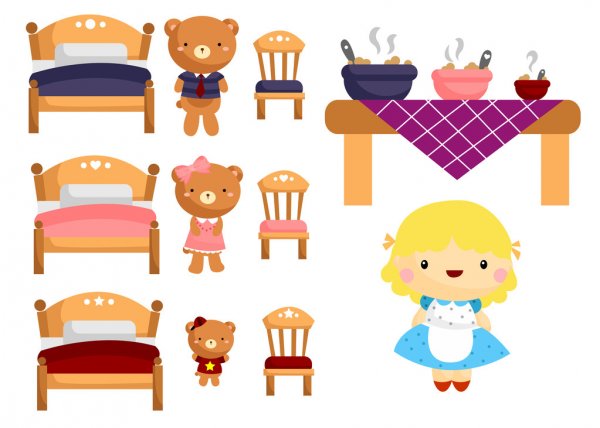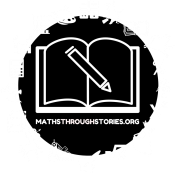In this blog post, Professor Camilla Björklund (University of Gothenburg, Sweden) and Professor Hanna Palmér (Linnaeus University, Sweden) highlight some cautions for teachers and parents when consider using stories like Goldilocks and the Three Bears to support mathematics learning of their children.
In our collaborations with teachers in projects aiming to develop early childhood mathematics education, we often come across traditional stories used for pedagogical purposes. These stories are used in many creative ways, as role plays, with or without props, keeping the traditional script as well as extending the story including non-traditional elements. Haven’t you, for example, heard about Goldilocks riding a motorcycle (see Pramling et al., 2019)?
In early childhood education, mathematics is preferably situated in familiar and meaningful settings for children and research supports the use of stories for pedagogical purposes. Narratives make the learning content interesting and appealing (Carlsen, 2013), and frame the content in ways that facilitate for the children to learn mathematical concepts and relationships (Björklund & Pramling Samuelsson, 2013; Burton, 2002). However, using stories for pedagogical purposes is no simple matter. For example, to facilitate learning, the mathematical content of the story has to be made explicit and challenged. This is not easy as stories often entails a complexity that may hinder the discovery of mathematical content, unless the teacher has an advanced understanding of the concepts in question. To highlight this complexity, the narrative of Goldilocks will here be used as an example. (For a more detailed analysis, see Palmér & Björklund, 2020.)
What mathematical challenges does the story impose?
In Goldilocks, the number three (bears, bowls, chairs, and beds) is an evident mathematical content. Another content is seriation (size, warmth, and softness). A third content of a mathematical kind is the relation to Goldilocks herself – as a reference point for what is “just right”. In the story, the idea of series may be challenged through this reference point when Goldilocks finds something that is “just right”. This, since what is considered “just right” is not consistent throughout the story, for example:
She tasted the porridge from the first bowl [Papa bear’s]. “This porridge is too hot!” she exclaimed. She tasted the porridge from the second bowl [Mama bear’s]. “This porridge is too cold,” she said. She tasted the last bowl of porridge [Baby bear’s]. “Ahhh, this porridge is just right.”
The porridge is in accordance with the recurring series Papa bear–Mama bear–Baby bear, by first tasting from the largest bowl, then the middle-sized bowl and last from the smallest bowl. But the temperature of the porridge is first too hot, then too cold and finally just right. Shouldn’t “just right” be a temperature between hot and cold? In the story, the sequence of warmness does not follow the increasing or decreasing structure that the sizes of the bowls indicate. The same ambiguous relation between size and other elements of order occurs also in other parts of the story:
“This chair is too big!” she exclaimed, sitting on the first chair [Papa bear’s]. So she sat in the second chair [Mama bear’s]. “This chair is too big, too!” she whined. So she tried the last chair [Baby bear’s]. “Ahhh, this chair is just right,” she sighed. But just as she settled down into the chair to rest, it broke into pieces!
Obviously, the last chair, which was the smallest one, was not right for Goldilocks, since she broke the chair while sitting in it. And once more, a visible series of sizes is offered for the children to perceive, but not related to the size of Goldilocks but to her own judgement:
She lay down in the first bed [Papa bear’s], but it was too hard. Then she lay in the second bed [Mama bear’s], but it was too soft. Then she lay down in the third bed [Baby bear’s] and it was just right.
Thus, the story entails a complexity that may hinder the emergence of mathematical learning if the mathematical meaning and discrepancies found in the story are not brought to the forefront and explored. Despite these challenges, we strongly encourage teachers to use narratives for pedagogical purposes, not least because of the coherence and interrelationship between concepts that are enabled through the narratives. Visual props may be used to illustrate this mathematics (for example, series of chairs in three different sizes). In our observations, children direct their attention primarily to the visual props, which often are contradictive in meaning in relation to the verbal story, as in Goldilocks. A teacher who may not have noticed the illogical structure of the narrative will probably not elaborate this with the children, resulting in the mathematical concepts becoming difficult for the children to discern. However, being aware of the discrepancies between the visual series and the narrative may open up for many learning opportunities and exploration of mathematical meaning together with children in early childhood education, as the contrast in the series can be compared, explored and the meaning of series learnt. To summarize, using stories for pedagogical purposes is not simple but fun and well-suited matter.
References
Björklund, C. & Pramling Samuelsson, I. (2013). Challenges of teaching mathematics within the frame of a story – a case study. Early Child Development and Care, 183(9), 1339–1354. DOI:10.1080/03004430.2012.728593
Burton, L. (2002). Children’s mathematical narratives as learning stories. European Early Childhood Education Research Journal, 10(2), 5–18.
Carlsen, M. (2013). Engaging with mathematics in the kindergarten. Orchestrating a fairy tale through questioning and use of tools. European Early Childhood Education Research Journal, 21(4), 502–513.
Palmér, H. & Björklund, C. (2020). Framing mathematics teaching with narratives – the ambiguity of Goldilocks. In M. Carlsen, I. Erfjord & P.S. Hundeland (Eds.), Mathematics Education in the Early Years. Results from the POEM4 Conference, 2018. (pp. 249-262). Cham: Springer.
Pramling, N., Wallerstedt, C., Lagerlöf, P., Björklund, C., Kultti, A., Palmér, H., Magnusson, M., Thulin, S., Jonsson, A., & Pramling Samuelsson, I. (2019). Play-responsive teaching in early childhood education. Dordrecht, the Netherlands: Springer. https://link.springer.com/book/10.1007%2F978-3-030-15958-0
About the authors
|
Prof. Camilla Björklund is a Professor in Education at the University of Gothenburg, Sweden. She is involved in several research projects within the field of mathematics learning and teaching in early childhood education, characterized by practice-oriented research questions and designs. She has frequently published scientific reports and books for teacher students and practicing teachers, particularly within the field of teaching about numbers and arithmetic in the early years.
|
|
Prof. Hanna Palmér is a Professor in Mathematics Education at Linnaeus University, Sweden. Her research is focused on mathematics teaching and learning in preschool, preschool class and primary school. Of special interest is problem solving, digital technology and entrepreneurial competences in mathematics education, as well as the professional identity development of mathematics teachers.
|



